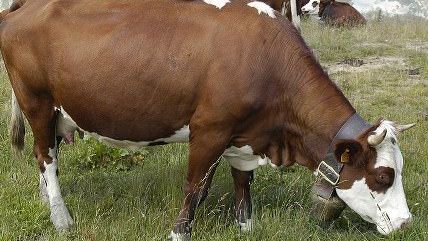Breaking the USDA's Slaughterhouse Stranglehold
The recent recall of nearly 9 million pounds of meat highlights the fact that USDA regulations make eating truly "local" meat difficult for consumers. How can we fix that?


Local food advocates and the USDA both encourage you to get to know your farmer. Many consumers choose to do just that.
But what if USDA regulations make futile the time and effort and money that a farmer and a consumer put into building this acquaintance?
That's exactly the case when it comes to USDA mis-management of the process for slaughtering the animals we eat, a fact that recent events have hammered home.
Early last month, the USDA shuttered the lone slaughterhouse in Northern California, Rancho Feeding Corp. in Petaluma, for unspecified violations, and ordered a staggering 8.7 million pounds of beef processed there in 2013 to be recalled. While the USDA has been tight-lipped on the reasons for the shutdown, word leaked late last month that the plant had been closed because it processed some cattle that were suffering from cancer.
If true, the USDA action makes sense on its face. Cancer is an adulterant and shouldn't be in the food supply.
Looked at more closely, though, the Rancho closure is a stark reminder that the USDA's own policies are largely to blame for this food safety problem. After all, the agency is responsible for channeling animals from farmers and ranchers of all sorts—from the smallest grassfed beef farmer to his largest competitor—into a limited number of USDA-approved slaughterhouses. According to USDA data, California has just four approved slaughterhouses. Texas has but one. Many states have none.
Why so few slaughterhouses? The "processing, marketing and distribution networks that once made small farming viable… disintegrated in the last 30 years as U.S. agriculture went through a dramatic consolidation," reported the Washington Post in 2010.
"The decline of small-scale USDA-inspected slaughterhouses comes as the demand for pasture-raised niche meats is soaring," noted USA Today in a 2010 article.
In other words, the increased demand for niche meats is being suppressed by a dearth of slaughterhouses.
A report last year in Washington State's Spokesman-Review detailed the problem. Farmers and ranchers are free to use slaughterhouses that are not inspected by the USDA. But meat from animals slaughtered there "must be sold to the consumer before it is butchered."
"Since a steer yields about 400 pounds of meat, that's often too much for a single family," reported the Spokesman-Review. "Several families can go together to purchase an animal, but that's more hassle for the rancher. And it doesn't address the needs of individuals who just want to purchase a few steaks or some ground chuck."
The result, as NPR reported in 2012, is that "many local meat products are sent to slaughterhouses hundreds of miles away, across state lines."
The impact of limiting where animals can be slaughtered have real-world consequences—including the Rancho recall.
When the USDA announced the Rancho recall, for example, that recall ensnared not only allegedly cancerous cattle from an unknown culprit or culprits but also that of every other producer who's had an animal slaughtered in the Rancho Feeding plant in the last year—out of what the San Francisco Chronicle termed "an abundance of caution… to make sure none of the cancerous meat commingled with healthful beef."
That includes cattle sent to Rancho by famed grassfed farmer Bill Niman, who told the Chronicle that he's out almost $400,000 even though his 427 cows were cancer-free and he could prove to the USDA that those cattle were not commingled with the diseased meat.
Niman's wife, Nicolette, an environmental law attorney and author of the book Righteous Porkchop, wrote an excellent op-ed that appeared in last week's New York Times. In the piece, she laments the recall as an overbroad reaction akin to chopping down hundreds of different orchards thanks to one bad apple.
"The Agriculture Department's tools for safeguarding the nation's meat supply are blunt and clumsy instruments, especially when dealing with independent farmers," she writes.
These USDA policies aren't just stupid—they're also reckless. And the alleged "abundance of caution" the department claims to be exercising now—after the fact—is entirely the result of its own recklessness.
The Rancho recall is part of a much larger problem that's existed for decades in the USDA inspection process.
In 2007, USDA officials were forced to admit to Congress that for at least 30 years, "U.S. inspectors visited 250 meat processing plants as rarely as once every two weeks despite federal law requiring daily inspection."
What's the alternative? Without this USDA stranglehold, local abattoirs could flourish, recalls like the one in California would become less common, and those that do occur would have a much smaller impact on farmers, consumers, and the food supply.
If Rancho employees or those supplying animals for slaughter there are guilty of crimes, then those responsible should suffer the consequences. But why should innocent farmers and ranchers—and countless cattle whose lives were wasted and whose meat will be destroyed—have to suffer because idiotic USDA regulations and high costs force the sort of consolidation that caused these problems in the first place?
I'm not arguing that meat raised on large farms and ranches and slaughtered in large-scale slaughterhouses is a bad choice. Such meat is typically cheaper than the boutique alternatives.
But USDA regulations effectively force consumers who want to support small-scale, local farmers to buy meat that's been processed in the same large slaughterhouses that larger competitors use. Consequently, consumers who don't want to support large-scale agriculture have few, if any, ways to opt out of that USDA-supported system.
The USDA should (as the Commerce Clause would seem to require) immediately halt any inspection requirements for meat that's raised, slaughtered, and sold in any one state. Let states and municipalities and farmers and consumers decide what inspection system is right for them. Then—and only then—will the "local" in local foods be more than an aspiration.
Note: For those of you who live in the Boston area and are interested in this issue, I'll be moderating a panel that will focus on many of these issues at The Meat We Eat Forum at Harvard Law School in April.
Update 03/10: Prof. Jayson Lusk points out in an email to me that there are likely far more slaughterhouses than those I linked to here in my column. The general principles I outline and criticize--of blanket USDA control and commingling--remain valid.


Show Comments (79)